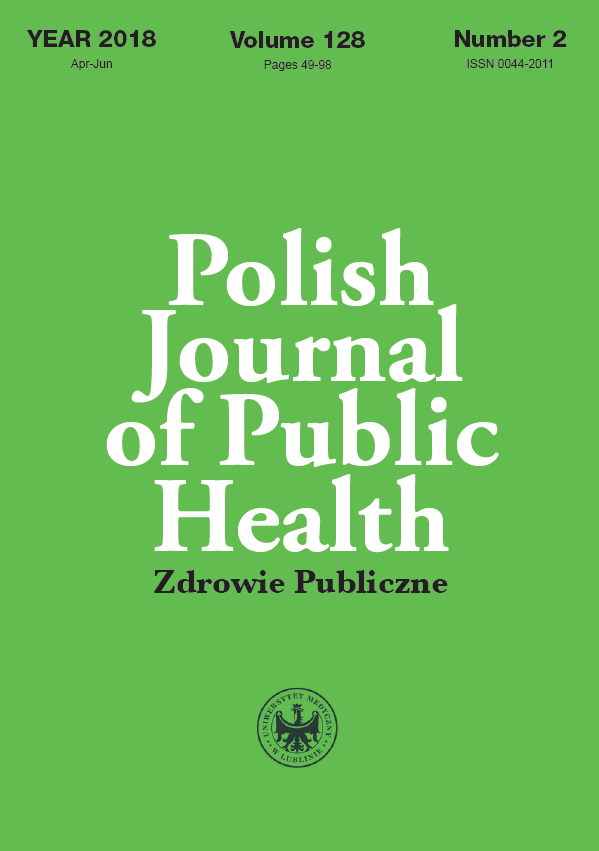Patients’ opinions on gynaecologists – experiences and assessments
DOI:
https://doi.org/10.2478/pjph-2018-0015Keywords:
gynaecologist, gynaecologist appointment, patient’s perspective, gynaecological care in PolandAbstract
Over the last few years, relatively close attention has been paid to analysing the attitudes of women to routine health check-ups and their knowledge of the risks associated with cervical cancer and breast cancer. What could also provide inspiring insights for scientific exploration, not only in the context of prevention, are the relationships between gynaecologists and their patients, gynaecologist appointment experiences, and satisfaction with care quality. It is important to note that the fear of the gynaecologist could be a serious barrier for women, and having a doctor they can trust has a positive impact on the regularity of their appointments. At the same time, negative experiences associated with the uneasy and perhaps embarrassing gynaecological examination, or doctor’s behaviour, are by no means the only reasons why women avoid such appointments. This article presents an up-to-date overview of the use of gynaecological care in Poland, along with findings from selected western studies
References
1. Ślusarska B, Zarzycka D, Wysokiński M, et al. Health behaviours and cancer prevention among Polish women. Eur J Cancer Care.2010;19(6):786-94.
2. Najdyhor E, Krajewska-Kułak E, Krajewska-Ferishah K. Wiedza kobiet i mężczyzn na temat profilaktyki raka piersi. Ginekol Pol. 2013;84:116-25.
3. Sulima M, Lewicka M, Wiktor K, et al. Ocena wiedzy kobiet na temat seksualnych czynników ryzyka raka szyjki macicy. Pomeranian J Life Sci. 2016;62(1):78-84.
4. Łuszczyńska A, Bukowska-Durawa A. Dlaczego Polki nie robią badań cyto-logicznych. Badanie przeprowadzone na zlecenie firmy Siemens. Apr 2011.
5. Lorenc B, Chełstowski A. Cytologia. Wyniki omnibusa. Millward Brown/ Millward Brown SMG/KRC. Jun 2012.
6. Ostrowska A. Profilaktyka zdrowotna: interpretacje, definicje sytuacji, racjonalności (Przypadek profilaktyki ginekologicznej kobiet). Studia Socjol. 2011;3:73-94.
7. Ostrowska A. Profilaktyka dla ubogich. Przypadek profilaktyki raka szyjki macicy. Zdr Publ Zarz. 2011:9105-12.
8. Badanie postaw wobec zachowań zdrowotnych w zakresie profilaktyki nowotworowej wśród mieszkańców Polski ze szczególnym uwzględnie-niem postaw Polek wobec raka szyjki macicy i raka piersi. Raport z bada¬nia przeprowadzonego przez Kantar Millward Brown na zlecenie Mini-sterstwa Zdrowia – Biura Prasy i Promocji. Warszawa; 2017.
9. Piątkowski W, Sadowska A, Bobiński M, Bednarek W. Nierówności w zdrowiu w świetle wyników projektu „Problem zgłaszalności kobiet na badania cytologiczne w Polsce. Próba analizy socjomedycznej”. Acta Universitatis Lodzensis. Folia Sociologica. 2015;55:149-65.
10. Piątkowski W, Sadowska A. Wokół profilaktyki onkologicznej. Charak¬terystyka uwarunkowań zachowań zdrowotnych kobiet objętych Popula¬cyjnym Programem Profilaktyki i Wczesnego Wykrywania Raka Szyjki Macicy. Komunikat z badań. Acta Universitatis Lodzensis. Folia Socio¬logica. 2016;58:145-54.
11. Niziurski P. Women’s opinions about stress during a visit to the gynaecolo¬gist’s office. Studia Med. 2016;32(2):96-101.
12. Schnatz PF, Murphy JL, O’Sullivan DM, Sorosky JI. Patient choice: comparing criteria for selecting an obstetrician-gynecologist based on image, gender, and professional attributes. Am J Obstetr & Gynecol. 2007;197(5):548-548.
13. Bojar I, Wdowiak L, Ostrowski T. Patients’ quality assessment of ambu¬latory obstetric and gynaecological services. Rocz Akad Med Bialymst. 2005;50:319-21.
14. Krajewska-Kułak E, Chilicka M, Kułak W, et al. Assessment of physician-patient trust in the obstetrics and gynecology departments in Poland and Greece. Ginekol Pol. 2011;82(12):905-10.
15. Hill AE, Smith CV, Hadden BW. Autonomy in the obstetrician/gynecolo¬gist-patient relationship as a predictor of patient satisfaction. Yale J Biol Med. 2013;86(2):179-88.
16. Janssen SM, Lagro-Janssen ALM. Physician’s gender, communica¬tion style, patient preferences and patient satisfaction in gynecology and obstetrics: A systematic review. Patient Education & Counseling. 2012;89(2):221-6.
17. Wonatowska P, Skonieczna J. Opieka ginekologiczna z perspektywy pacjentek ze szczególnym uwzględnieniem osób w wieku 12-25 lat, LBTQ oraz z niepełnosprawnościami. J Edu, Health and Sport. 2015;5(8):343-52.
18. Rymer J, Durbaba S, Rosenthal J, Jones RH. Use of chaperones by obste¬tricians and gynaecologists: a cross-sectional survey. J Obstetr & Gynae¬col. 2007;27(1):8-11.
19. Morgan R, Katzman DK, Kaufman M, et al. Thanks for asking: Adolescent attitudes and preferences regarding the use of chaperones during physical examinations. Paediatrics & Child Health (1205-7088). 2016;21(4):191-5.
20. Neuhaus LR, Memeti E, Schäffer M-K, et al. Using a wrap skirt to im¬prove the pelvic examination experience. Acta Obstet Gynecol Scand. 2016;95:534-40.
21. Kocabas P, Khorshid L. A comparison of the effects of a special gynaeco¬logical garment and music in reducing the anxiety related to gynaecologi¬cal examination. J Clin Nurs. 2012;21(5-6):791-9.
22. Volpe RL. Meeting the doctor with my clothes on. Am J Bioeth. 2011;11(12):69-70.
Downloads
Published
Issue
Section
License
Copyright (c) 2018 Polish Journal of Public Health

This work is licensed under a Creative Commons Attribution-NonCommercial-NoDerivatives 3.0 Unported License.


